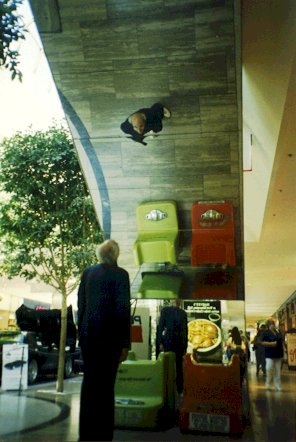A closing thought on this odd business of light, dark, contrast and contradiction: One day I was casting about for my next radio topic and my wife asked me, "Why don't you do a program on mirror images?" And I knew I was in trouble!
On the one hand, mirrors seem too commonplace and obvious, to provide grist for a technical talk. On my other (mirror image) hand, I realized that mirrors offer such an embedded paradox that we hardly have a vocabulary to talk about them.
Her remark was triggered by a program I did on chiral chemistry. A chiral material is one whose molecules are identical in every feature but one, and that one has to do with mirrors. Suppose your mirror self were to step out of the mirror. Her hair would be parted on the wrong side. Her watch would be on the wrong wrist. There's no way you could turn her around to make her into you. She would not be you. That creature would be wrong in the same way as a left-handed handshake from a friend is wrong.

The word chiral comes from the Greek for hand, because our hands are mirror images. One chiral molecule is the reversed mirror image of the other. That means there's no way to rotate one molecule to make it into the other. That tiny difference is enough to make otherwise identical materials behave differently.
When I was young, I saw the 1945 Michael Redgrave movie, The Dead of Night — a set of six horror stories. The Dead of Night created conventions of movie terror that we've used ever since. Everything in it has been copied until it's hackneyed. But this was the first time I saw the trick of a mirror reflecting a scene unlike the one in front of it. It was terrifying. Mirrors made me uncomfortable for years after that.

Disorienting mirror images
Engineers make great use of mirror images. Suppose a pipe carries hot water inside a concrete block, parallel with an insulated surface of the block. How to calculate heat flow in the concrete? The easiest way is to replace the insulation with a mirror image of the concrete and the pipe. It's far simpler to calculate the effect of the mirror image, and the answer's just the same as it is for the single real pipe.
The subtlety of mirror images shows itself in how long it took chemists to learn why seemingly identical molecules don't behave the same. Pasteur first found such molecules in 1847. But it was this century before people figured out the part of about chirality — that the two molecules reflected each another.
Mirror imaging has become a regular tool in our bag of scientific and engineering tricks. Opposed images cut through complexity and disorient us at the same time. No wonder our legends teem with mirrors. Think of vampires, fun houses, bad luck — the infinite regress of self in opposing barber shop mirrors. Think of the face of Medusa which turns us to stone unless we view her in a mirror.
Think of some of the many mirrors that operate just beyond our awareness. The ocean floor has a topography not unlike a casting of Earth’s surface. The Mariana Trench is only about 20 percent deeper than the height of the Himalayas. The rear-view mirror in our car reverses what we see when we turn and look behind us, yet we’re so adapted to that fact, that we have to stop and think for a beat before we accept that reversal as true.
Mirrors are indeed a perpetual brain teaser. Perhaps that's why 17th-century mystic, George Herbert, once said, "The best mirror is an old friend. "For old friendships invariably prove to be just as dear — and just as subtly complex and puzzling — as that seemingly simple mirror we look into, first thing every morning.
Well, we’ve exhausted our time and I’ve only scratched the surface. But no matter: your ever-restive mind will go on to summon up so many more of the contradictions and complications that are framed in the unending flow of darkness and light.

This photo of JHL and a mirror is by Carol Lienhard
Sources
Image and photos in text above are by JHL — with the exception of the one above (Carol Lienhard).